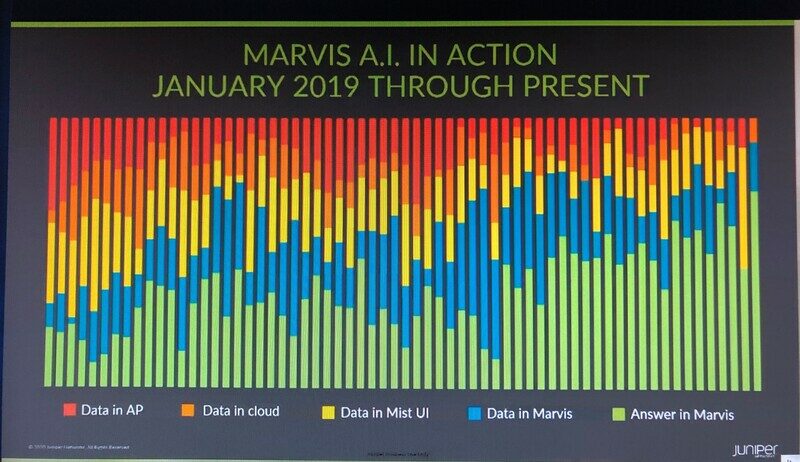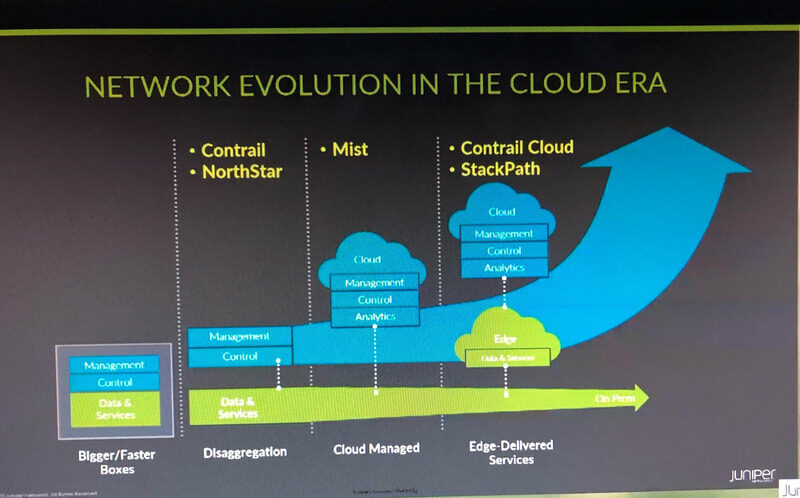We attended a well-organized and information-packed virtual conference hosted by Juniper Networks last week. While there were many themes (400G, telco cloud, AI, Mist), the one that really came through was how much the Mist acquisition has reinvigorated the Juniper organization. About a year ago, Juniper made its acquisition of the Wi-Fi startup. It is clear a year later that Juniper’s Enterprise strategy has been “Mistified.” We will share some Mist statistics from conference and our thoughts, as well.
Juniper shared some milestones that now characterize the Juniper Enterprise group:
- 4 of the Fortune 10 are Mist Wi-Fi customers
- 3 of the Fortune 10 are AI customers for wired as well as wireless
- By 4Q20, Juniper will make its SD-WAN products assured by Mist AI, thereby completing the single-pane managed system that will include Wi-Fi, Ethernet Switches, Security and SD-WAN. In slightly over a year, the AI operations system (AIops) from Mist will support the Enterprise products that Juniper had in house prior to the merger.
- Since January 2019 through last month, the Mist AI system has improved to the point where Marvis, the company’s Virtual Network Assistant, can resolve 80% of customer inquiries, compared to 20% in January 2019.
We asked the company what has worked well with the acquisition, including whether the deal structure may have contributed towards to its success. Juniper executives explained that there was nothing special about how the acquisition was structured beyond the normal incentives for the acquired team. What happened after the acquisition, though, is somewhat unique: in effect, the Enterprise group at Juniper was subject to a reverse merger with Mist, whereby the Mist management team now leads the group. Perhaps the fact that the Mist team is in charge of the show explains the rapid integration of the existing Juniper products into the Mist AI management system. Perhaps, also, the integration went well was because the Juniper products (switches, SD-WAN and Security) were designed to collect and easily share telemetry data for use by the Mist AI system.
Juniper also featured a customer – whose name we cannot share – that is a major fast food chain across the US. It currently has 10,000 Wi-Fi Access Points with another vendor and recently made the decision to replace them with Mist Wi-Fi 6 APs by the end of 2022. We found it interesting how important support is for IoT and the increased importance of outdoor Wi-Fi during the pandemic. The company is deploying four indoor APs and three outdoor APs per restaurant. The customer spokesperson shared that Mist does AI-based, dynamic radio resource management (RRM) very well and he shared numerous screenshots showing power levels that were kept around 11-13 dBm instead of values he recalls seeing closer to 20 on the existing infrastructure. At this point, the customer has installed Mist APs in over 50 restaurants and he says he has not had a single Wi-Fi-related trouble ticket from these locations. He is also looking to implement location services in the future with the company’s vBLE technology.
The company’s cloud-based location analytics capability is designed to serve as a contact tracing and crowd management system to allow Juniper WLAN customers to reduce risks as employees and visitors go to the campus environment. The company introduced this contact tracing capability in May 2020. The company said its cloud-based contact tracing service is something that can operate on top of Juniper infrastructure, as well as its competitors. The company shared details about a large elite US university that is using the service and decided to upgrade to Juniper WLAN infrastructure as well.
Our view is that Juniper is well-positioned in the Enterprise market because by year-end it will have an AI-driven, single-pane operations system that covers Wi-Fi, Ethernet Switching, Security and SD-WAN. This is an enviable position because increasingly customers are making purchasing decisions for various equipment at the same time, and they are looking to reduce ongoing operational costs. By managing a system with a single-pane, customers can correlate customer experience, application responses and network issues in an integrated system, and pinpoint corrective action. This is not to say that Juniper has an exclusive on single-pane managed systems covering all these network systems – Cisco, Fortinet and others lay claim in the same. Juniper is in good company.

